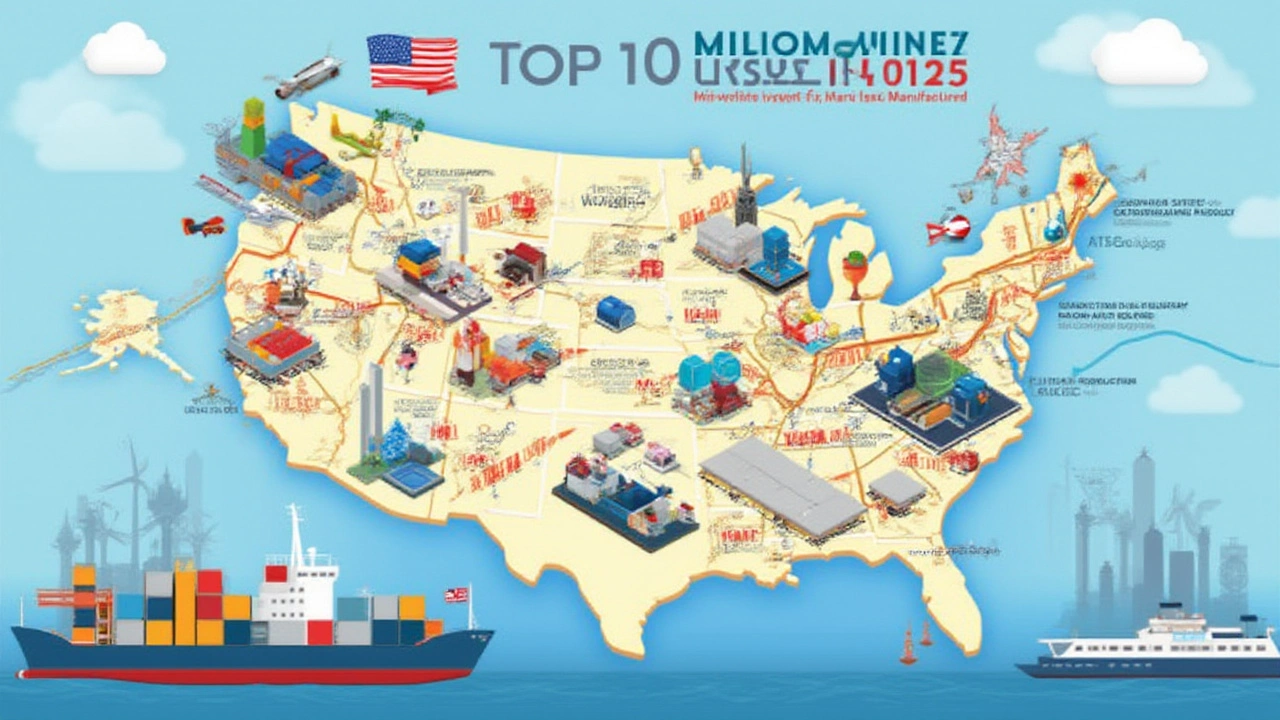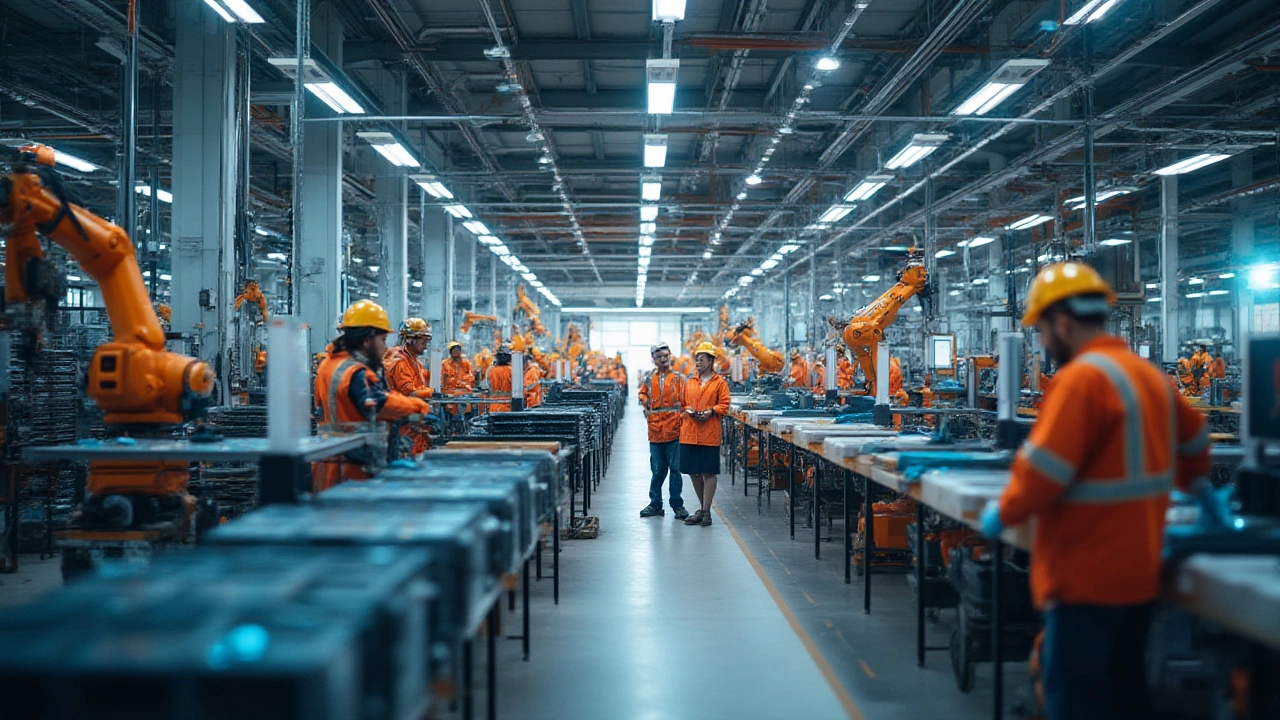Every time you pick up your smartphone or hop in your car, you’re touching a piece of America’s massive manufacturing machine. But what’s really driving the USA’s factories these days? If you think it’s only Detroit’s pickup trucks, it’s time to dig a little deeper. US manufacturing is a mind-boggling web that stretches from high-tech chips to old-school steel, with each sector powering big jobs, big exports, and even bigger money. It’s not all robots and assembly lines either. Workers, small towns, and huge cities owe a lot to what gets made—and sold—within America’s borders. The numbers might surprise you, the variety even more so. There’s more to the story than just cars and planes. Here’s where the action is, and why it matters now more than ever.
The Powerhouse: Automobiles and Aerospace
Let’s start with what most people picture first—those shiny SUVs, pickups, and jets that stamp “Made in USA” all over the world. Car making is still the biggest manufacturing gig in America. Nearly 10 million vehicles rolled off US lines last year, powered by factories spread all across Michigan, Kentucky, and Texas. Ford, GM, and Tesla grab headlines, but don’t forget about all the suppliers—hundreds of factories churning out everything from seats to dashboards—filling thousands of blue-collar jobs. New electric vehicles (EVs) are shaking things up, too. Tesla’s gigafactories now build as many battery packs as Model Ys, while old names like Ford rush to grab a share of the EV boom. It’s not just assembly though. The US is home to some of the world’s most advanced engine plants, pushing out parts for everything from tractors to jet fighters.
Look up, and you’ll spot America’s other big moneymaker: aerospace. Boeing, Raytheon, and Lockheed Martin fill the sky—and balance sheets—with commercial jets, fighter planes, and missiles. Boeing’s 737 and 787 lines pump billions into the US economy. After a rocky few years, demand for new jets is back up, especially as airlines replace old planes with newer, fuel-efficient models. And with global defense spending hitting record highs, US-made helicopters, drones, and military jets are guaranteed exports. These industries don’t just pay the bills at giant companies—they support hundreds of thousands of machine operators, engineers, and logistics workers, from Seattle to Savannah.
Need proof? Take a look at these recent numbers:
| Product | Annual Production Value (2024, USD) | US Jobs Supported |
|---|---|---|
| Autos & Light Trucks | $850 billion | 920,000 |
| Aerospace & Defense | $710 billion | 650,000 |
So, if you’re ever stuck in traffic or stuck on a flight, just remember, you’re moving through America’s two biggest manufacturing stories.
Tech Titans: Electronics, Semiconductors, and Computers
From the microchips in your smartwatch to the supercomputers used by NASA, the US electronics industry is having a serious moment. If you thought Silicon Valley was just about software, think again. Leading the way are companies like Intel, AMD, and Texas Instruments, making chips that power everything—cars, healthcare gadgets, even household appliances. The COVID-19 pandemic squeezed supply chains hard, and in response, US firms have doubled down on advanced chip manufacturing. New “fabs”—some the size of football stadiums—are popping up in Arizona and Ohio, promising to make more semiconductors on American soil than ever before.
Don’t ignore computers and consumer electronics—think Apple’s Macs, Dell’s servers, or HP’s printers. Apple alone employs over 90,000 people in the US, and sources from hundreds of American suppliers for its products. And it’s not just Silicon Valley churning out the goods. States like Texas and North Carolina have quietly become huge electronics hubs, hosting robotics firms, IT hardware makers, and communication gear companies. Robotics and automated systems for warehouses and factories also count toward these numbers. With AI and “smart” everything on the rise, American electronics exports hit $350 billion last year—and that’s still climbing.
What should you watch for? Some of the highest-paying manufacturing jobs in the country are in chip making or advanced electronics assembly. Giant investments in these sectors could mean new opportunities if you’re looking to get into tech from a non-coding angle. The competition with China is real, and Washington’s “CHIPS Act” is fueling billions in new investment for chip facilities, all to keep American tech at the cutting edge.

America’s Economic Staples: Chemicals, Pharmaceuticals, and Food Products
Let’s not pretend everything made in America is a machine or a gadget. Chemical manufacturing is one of the real unsung heroes, filling our medicine cabinets and fueling the world’s crops. Dow, DuPont, and ExxonMobil oversee massive plants that make industrial chemicals, paints, plastics, and fertilizers. These are the building blocks for so many other industries—try making cars, packaging, or electronics without them. Nearly 15,000 chemical manufacturing facilities keep over 800,000 Americans employed, many in communities where this is the only game in town.
Pharma is next, and it’s gone wild since the pandemic. Pfizer, Johnson & Johnson, and Eli Lilly develop vaccines, treatments, and literally billions of tablets each year on US soil. Medicine was America’s #1 export in 2024, pulling in $170 billion in revenue. Big pharmaceutical plants stretch from the Northeast to the Midwest, with billions sunk into cleanrooms, labs, and distribution hubs. Regulatory pressure is sky-high, but so are demand and innovation. Jobs in pharma tend to pay well, and there’s a constant need for both high-skill scientists and everyday plant operators.
And then there’s food. Think of Tyson, Kraft Heinz, Archer Daniels Midland—giants behind your chicken nuggets and salad dressing. American food manufacturing mixes scale with obsession for detail, from dairy products to craft beer and soy protein. The US exported $160 billion in food products last year, and it’s not all corn dogs and soda. Organic, plant-based, and health-focused foods are on the up, and factory innovations mean your frozen pizza probably traveled hundreds of miles in perfect chill before reaching your oven.
Want a quick snapshot?
| Product | Annual Production Value (2024, USD) |
|---|---|
| Chemicals & Plastics | $625 billion |
| Pharmaceuticals | $495 billion |
| Food & Beverage | $740 billion |
This trio of essential sectors isn’t glamorous, but they’re what keep shops stocked, medicine cabinets full, and the economy humming.
Heavy Hitters: Metals, Machinery, and Oil Refining
Head out of the big cities, and you’ll run right into America’s heart of steel—literally. Steel and metals manufacturing powers everything from skyscrapers to soup cans. Big firms like Nucor and U.S. Steel crank out over 90 million tons of steel a year, feeding industries that make cars, buildings, shipping containers, and heavy machines. The rise of ‘green steel’—made using low-carbon processes—is starting to change the game, and American plants are experimenting with hydrogen and electric arc furnaces to cut emissions.
Heavy machinery is another classic US success story. Caterpillar’s bright yellow bulldozers are instantly recognizable, but the full picture is even bigger—add John Deere’s tractors, industrial pumps, and the drilling rigs made in Texas and Oklahoma. Sales in this category topped $375 billion last year. Advanced machines aren’t just for digging holes anymore. Smart, AI-driven manufacturing robots now assemble robots—seriously—at US plants, helping push both productivity and safety for workers.
Oil and gas refining is still a backbone of US output. American refineries, mostly rooted in the Gulf Coast, process nearly 17 million barrels of crude oil every single day. That powers millions of cars, planes, and factories. While the push toward renewables is real, oil refineries aren’t going away anytime soon. Refined petroleum products like gasoline, diesel, and jet fuel routinely top export charts, with Canada and Mexico among the biggest customers. And new biofuel facilities are starting up, blending traditional oil with plant-based stocks for a greener footprint.
Keep an eye on metals recycling too—it’s becoming a serious business thanks to consumer gadgets and old cars. Urban mining—basically turning old electronics and appliances into raw materials for new products—is the next frontier. That’s creating jobs in rust-belt towns and reducing the need for imported metals.

The Future List: Plastics, Medical Devices, and Emerging Sectors
You might not think about plastics until you’re hunting for your recycling bin, but this is a monster industry for America. The plastics sector racked up more than $390 billion in output last year. Packaging, parts, insulation, and thousands of everyday products start their life as plastic resin made in huge US plants. There’s a lot of recycling happening now—opportunities everywhere for new tech that can break down old plastics and turn them into fuel or new products.
Medical devices—like the knee replacements, blood testers, and insulin pumps now common in hospitals—are a hidden powerhouse. Companies such as Medtronic, Boston Scientific, and Abbott employ tens of thousands of Americans making tools and implants that get exported around the globe. With an aging population and demand for remote health monitoring, this sector is expected to double growth by 2030. Modern plants work almost like cleanrooms, and quality control is absolutely relentless—one tiny flaw, and the product can’t be used.
Don’t overlook clean energy gear and advanced materials—industries set to explode as the US government pours billions into solar panels, wind turbines, and battery tech. With climate change on everyone’s mind, US manufacturers are racing to make batteries that last longer, solar cells that cost less, and wind turbine blades that can handle tornado country. These jobs often pay better than older roles, need more technical skill, and come with the sense that you’re building the future, not the past.
Some quick tips if you’re eyeing a role in US manufacturing: specialize in automation, don’t ignore logistics (every product on this list moves thousands of miles), and consider learning Spanish, since bilingual skills are increasingly valued on US factory floors. If you want to tap into growth, follow government investment—where America spends its money, new jobs quickly follow.
Here’s a summary table for the top 10:
| Rank | Product Category | 2024 US Output (USD Billions) | Key States |
|---|---|---|---|
| 1 | Automobiles & Parts | 850 | Michigan, Kentucky, Texas |
| 2 | Aerospace Products | 710 | Washington, Georgia, Missouri |
| 3 | Food & Beverages | 740 | Illinois, California, Iowa |
| 4 | Chemicals & Plastics | 625 | Texas, Louisiana, Ohio |
| 5 | Pharmaceuticals | 495 | New Jersey, North Carolina, Indiana |
| 6 | Electronics & Semiconductors | 350 | California, Texas, Arizona |
| 7 | Petroleum & Coal Products | 445 | Texas, Louisiana |
| 8 | Machinery | 375 | Illinois, Indiana, Wisconsin |
| 9 | Medical Devices | 250 | Minnesota, Massachusetts, California |
| 10 | Fabricated Metals | 210 | Ohio, Pennsylvania, Michigan |
The US manufacturing landscape in 2025 looks nothing like what your dad or granddad described. It’s more high-tech, more diverse, and more competitive than ever. If you’re wondering where tomorrow’s big paydays, exports, and technological leaps will come from, keep your eyes on these top sectors. The battle for the next big thing is already underway on the factory floor.
